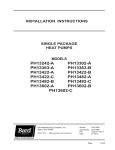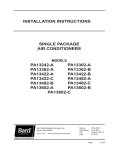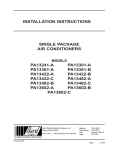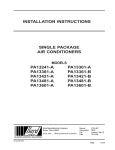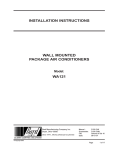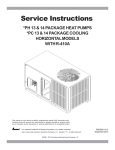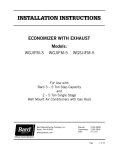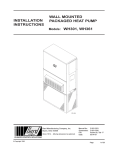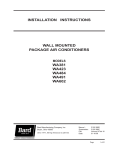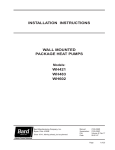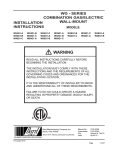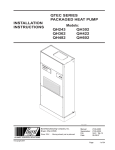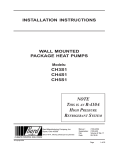Download Bard PH13482-B Troubleshooting guide
Transcript
INSTALLATION INSTRUCTIONS
SINGLE PACKAGE
HEAT PUMPS
MODELS
PH13242-A
PH13302-A
PH13362-A
PH13362-B
PH13422-A
PH13422-B
PH13422-C
PH13482-A
PH13482-B
PH13482-C
PH13602-A
PH13602-B
PH13602-C
Bard Manufacturing Company, Inc.
Bryan, Ohio 43506
Since 1914 . . . Moving ahead, just as planned.
© Copyright 2006
Manual :
Supersedes:
File:
Date:
2100-468E
2100-468D
Volume II Tab 11
05-28-09
Manual
Page
2100-468E
1 of 27
CONTENTS
Getting Other Informations and Publications
General Instructions
Important ................................................................
Shipping Damage ....................................................
General ................................................................
Field-Installed Heater Packages (Optional) .............
3
4
4
4
Installation
Location ................................................................ 9
Slab Mounting .......................................................... 9
Winter Installation .................................................... 9
Typical Installations ......................................... 9 & 12
Condensate Drain Trap ......................................... 12
Air Filters .............................................................. 12
Thermostats ........................................................... 13
Wiring – Main Power ............................................. 14
Wiring – 24V Low Voltage Control Circuit ............. 14
Thermostat Indicator Lamps .................................. 15
Emergency Heat Position ...................................... 15
Transformer Taps ................................................... 15
Compressor Cutoff Thermostat and Outdoor
Figures
Figure 1 Unit Dimensional Drawing ....................... 8
Figure 2 Slab Mounting at Ground Level ............ 10
Figure 3 Airflow and Service Access
Clearances ............................................ 10
Figure 4 Elevated Mounting Platform ................... 11
Figure 5 Condensate Drain Trap ......................... 12
Figure 6 Low Voltage Wiring ............................... 14
Figure 7 Unit 24V Terminal Board (5–10 KW) ..... 15
Figure 8 Unit 24V Terminal Board (15–20 KW) ... 16
Figure 9 Heat Pump Control Board ..................... 19
Figure 10 Fan Blade Setting ................................. 22
Figure 11 Brazing Diagram ................................... 25
Figure 12 Motor Connections ................................ 26
Figure 13 Wiring (Connections/Voltage) ............... 27
Start Up and Operation
General ..............................................................
Topping Off System Charge ...................................
Safety Practices .....................................................
Start Up Notes .......................................................
Three Phase Scroll Compressor Start Up
Information .............................................................
Sequence of Operation ..........................................
Defrost Cycle .........................................................
Troubleshooting
Solid State Heat Pump Control
Troubleshooting Procedure ...................................
Troubleshooting Guide ..........................................
Checking Temperature Sensor Check Out ............
Temperature vs. Resistance of
Temperature Sensor Chart ....................................
Service
Service Hints .........................................................
Pressure Service Ports ..........................................
Refrigerant Charge ................................................
Fan Blade Settings ................................................
Suction and Discharge Tube Brazing ....................
20
20
21
21
22
22
22
22
25
Troubleshooting GE ECM Blower Motors . 26 & 27
Tables
Table 1
Table 2
Table 3
Table 4
Table 5
Table 6
Table 7
Table 8
Table 10
Table 11
Table 12
Table 13
2100-468E
2 of 27
18
18
19
Pressure Tables ............................................. 23 & 24
Table 9
Manual
Page
17
17
17
17
Rated CFM and ESP .............................. 4
Electrical Data ......................................... 5
Optional Field Installed Heater
Packages ................................................ 6
Opt. Field Installed Elec. Heater ............. 7
Required Filters ..................................... 12
Heat Pump Thermostats ....................... 13
Thermostat Wire Size ........................... 13
Compressor Cutoff Thermostat
Wiring (5 - 10 KW) ............................... 16
Compressor Cutoff Thermostat
Wiring (15 - 20 KW) ............................. 16
Fan Blade Setting Dimensions .............. 22
Pressure Table - Cooling ....................... 23
Pressure Table - Heating ...................... 24
Indoor Blower Performance .................. 25
Getting Other Information and Publications
These publications can help you install the air conditioner
or heat pump. You can usually find these at your local
library or purchase them directly from the publisher. Be
sure to consult current edition of each standard.
FOR MORE INFORMATION, CONTACT
THESE PUBLISHERS:
ACCA
Air Conditioning Contractors of America
1712 New Hampshire Ave. N.W.
Washington, DC 20009
Telephone: (202) 483-9370
Fax: (202) 234-4721
ANSI
American National Standards Institute
11 West Street, 13th Floor
New York, NY 10036
Telephone: (212) 642-4900
Fax: (212) 302-1286
National Electrical Code ........................... ANSI/NFPA 70
Standard for the Installation ................... ANSI/NFPA 90A
of Air Conditioning and Ventilating Systems
Standard for Warm Air .......................... ANSI/NFPA 90B
Heating and Air Conditioning Systems
Load Calculation for ................................ ACCA Manual J
Residential Winter and Summer Air Conditioning
Duct Design for Residential ................... ACCA Manual D
Winter and Summer Air Conditioning and Equipment
Selection
ASHRAE American Society of Heating Refrigerating,
and Air Conditioning Engineers, Inc.
1791 Tullie Circle, N.E.
Atlanta, GA 30329-2305
Telephone: (404) 636-8400
Fax: (404) 321-5478
NFPA
National Fire Protection Association
Batterymarch Park
P.O. Box 9101
Quincy, MA 02269-9901
Telephone: (800) 344-3555
Fax: (617) 984-7057
Manual
Page
2100-468E
3 of 27
GENERAL INSTRUCTIONS
These instructions and any instructions packaged with any
separate equipment required to make up the entire heat
pump system should be carefully read before beginning the
installation. Note particularly “Starting Procedure” and any
tags and/or labels attached to the equipment.
IMPORTANT
The equipment covered in this manual is to be installed by
trained, experienced service and installation technicians.
Any heat pump is more critical of proper operating charge
and an adequate duct system than a straight air conditioning
unit. All duct work, supply and return ducts, must be
properly sized for the design airflow requirement of the
equipment. ACCA is an excellent guide to proper sizing.
All duct work or portions thereof not in the conditioned
space should be properly insulated in order to both
conserve energy and prevent condensation or moisture
damage.
While these instructions are intended as a general
recommended guide, they do not supersede any national
and/or local codes in any way. Authorities having
jurisdiction should be consulted before the installation is
made.
FIELD INSTALLED HEATER PACKAGES
(OPTIONAL)
SHIPPING DAMAGE
These packaged heat pumps are manufactured without
supplementary electric heaters. Supplementary heaters are
available for simple, fast field installation.
Upon receipt of equipment, the carton should be checked
for external signs of shipping damage. If damage is found,
the receiving party must contact the last carrier
immediately, preferably in writing, requesting inspection
by the carrier’s agent.
A separate power circuit is required for the supplementary
heaters.
IMPORTANT: Refer to Table 1 when designing duct work
for maximum available static pressure with heater installed.
GENERAL
Refer to Tables 2 and 4 for proper application information
on all available heater combinations and what units they
can be used with. It also shows the applicable circuit
ampacities, fuse size, and wire size for each heater
combination.
The refrigerant system is completely assembled and
charged. All internal wiring is complete.
The unit is designed for use with or without duct work.
Flanges are provided for attaching the supply and return
ducts.
These instructions explain the recommended method to
install the air cooled self-contained unit and the electrical
wiring connections to the unit.
TABLE 1
RATED CFM AND EXTERNAL STATIC PRESSURE (ESP)
Model
Rated
C FM
Recommended
Airflow Range
Rated
ESP
Maximum
ESP
PH1324
800
Note
0.10
0.50
PH1330
1000
Note
0.15
0.50
PH1336
1100
Note
0.15
0.50
PH1342
1400
Note
0.15
0.50
PH1348
1550
Note
0.20
0.50
PH1360
1750
Note
0.20
0.50
NOTE: Motor will adjust to deliver rated airflow.
Manual 2100-468E
Page
4 of 27
Manual
Page
2100-468E
5 of 27
Model
13
12
12
30
BC SC
Field Wire Size *
Ground Wire Size
Delay Fuse - Max. **
Fan Motor - HP/RPM
PH13362-A
PH13362-B
75 degree C copper wire
8
410
136
1000
3.3
1/2 ECM
24" 2600
1.1
1/6 / 825
79/79
15/17.5
230/208
Scroll
19.4/21.9
40
PH13422-A
PH13422-B
410
136
1000
3.3
440
170
1450
3.9
1/2 ECM
24"/3400
24"/2600
1/2 ECM
1.5
1/4 / 825
440
170
1450
3.9
1/2 ECM
24"/3400
1.5
1/4 / 825
115/115
11.3/12.0
16.1/17.1
115/115
230/208
Scroll
17.1/17.9
35
10
10
15
25
187-253
230/208
Scroll
21.9/22.9
50
10
10
21
33
197-253
1.1
1/6 / 825
88/88
9.5/11
230/208
Scroll
13.9/15.4
25
12
12
11
17.5
10
18
187-253
27
197-253
** Maximum time delay fuse of HACR type circuit breaker
*
136
75
360
Charge (R-410A oz.)
Shipping Weight (pounds)
410
1000
800
CFM Cooling
2.7
1/2 ECM
24"/2600
1.1
1/6 / 825
2.1
1/3 ECM
24"/2800
1.1
73/73
11/12.5
Blower Motor - Amps
Blower Motor - HP/RPM
Motor and Evaporator
Fan Dia/CFM
Fan Motor Amps
1/6 / 825
58.3/58.3
Lock Rotor Amps
Fan Motor and Condenser
8/9
Scroll
230/208
Scroll
14.8/16.3
30
10
10
14
22
197-253
230/208
Rated Load Amps
Volts
Compressor Type
11.2/12.2
20
Total Unit Amps - 203-208
197-253
Minimum Circuit Ampacity
Compressor - Circuit A
PH13302-A
230/208-60-1 230/208-60-1 230/208-60-1 230/208-60-3 230/208-60-1 230/208-60-3
PH13242-A
Operating Votage Range
Electric Rating
60 H z - C kt A
490
160
1450
3.9
1/2 ECM
24"/3400
1.5
1/4 / 825
50
7.7
460
Scroll
10.4
15
14
14
8
12
414-506
460-60-3
PH13422-C
TABLE 2
ELECTRICAL DATA
PH13482-B
180
440
440
180
1550
4.5
1550
3/4 ECM
4.5
24"/3400
1.5
500
160
1550
4.5
3/4 ECM
24"/3400
1.5
1/4 / 825
50
83.1/83.1
1/4 / 825
7.7
460
Scroll
10.7
20
14
12
8
14
414-506
460-60-3
PH13482-C
12.0/13.2
230/208
Scroll
18.0/19.2
40
10
10
14
29
187-253
3/4 ECM
24"/3400
1.5
1/4 / 825
117/117
18.7/20.6
230/208
Scroll
24.7/26.6
50
8
8
22
36
197-253
230/208-60-1 230/208-60-3
PH13482-A
PH13602-B
450
190
1750
5.0
3/4 ECM
24"/3400
1.5
1/4 / 825
134/134
19.3/22.9
230/208
Scroll
25.3/28.9
60
8
8
26
39
197-253
450
190
1750
5.0
3/4 ECM
24"/3400
1.5
1/4 / 825
110/110
11.7/13.9
230/208
Scroll
17.7/19.9
40
10
10
16
26
187-253
230/208-60-1 230/208-60-3
PH13602-A
500
160
1750
5.0
3/4 ECM
24"/3400
1.5
1/4 / 825
52
8.6
460
Scroll
11.9
25
12
10
9
17
414-506
460-60-3
PH13602-C
Manual 2100-468E
Page
6 of 27
240/208-1
240/208-1
240/208-1
240/208-3
240/208-3
240/208-1
240/208-1
240/208-1
240/208-3
240/208-3
460-3
460-3
EHP323-A05
EHP323-A10
EHP323-A15
EHP323-B09
EHP323-B15
EHP513-A05
EHP513-A10
EHP513-A15
EHP513-B09
EHP513-B15
EHP513-C09
EHP513-C15
X
X
X1
X1
X
X
X
X
X2
X
NA = Not approved.
A = Alternate application — heater voltage and phase different from basic unit.
X2
X
2 Max. KW that can operate with Heat Pump on is 9 KW. 15 KW
will operate during emergency heat.
1 Max. KW that can operate with Heat Pump on is 10 KW. 15 KW
will operate during emergency heat.
X2
X2
X2
X2
X
X1
X
X
X
X
X1
X1
X
X
X
X
X
PH13242-A PH13302-A PH13362-A PH13362-B PH13422-A PH13422-B PH13422-C PH13482-A PH13482-B PH13482-C PH13602-A PH13602-B PH13602-C
S = Standard application — heater voltage and phase same as basic unit.
Volts and
P h ase
Heater
P ackag e
Model
TABLE 3
OPTIONAL FIELD INSTALLED HEATER PACKAGES
ONLY TO BE USED WITH THE HEAT PUMP MODELS INDICATED
Manual
Page
2100-468E
7 of 27
5
10
15
5
10
15
9
15
9
15
9
15
EHP323-A05 240/208-1
EHP323-A10 240/208-1
EHP323-A15 240/208-1
EHP513-A05 240/208-1
EHP513-A10 240/208-1
EHP513-A15 240/208-1
EHP323-B09 240/208-3
EHP323-B15 240/208-3
EHP513-B09 240/208-3
EHP513-B15 240/208-3
EHP513-C09
EHP513-C15
30,700
51,200
30,700
51,200
30,700
51,200
17,100
34,100
51,200
17,100
34,100
51,200
B TU H
6.75
11.25
21.7/18.7
36.2/31.2
23,000
38,400
10.8
18
21.7/18.7
36.2/31.2
20.8/18.1
41.6/36.2
62.5/54.1
20.8/18.1
41.6/36.2
62.5/54.1
240/208V
Heater
Amps
23,000
38,400
12,800
26,000
38,400
3.75
7.50
11.25
6.75
11.25
12,800
26,000
38,400
B TU H
3.75
7.50
11.25
KW
Heater KW &
Capacity @
208 Volts
None
None
None
30/60
30/60
Heater
Internal
F u se
1
1
14
28
28/24
46/39
28/24
46/39
1
1
1
1
26/23
53/46
79/68
26/23
53/46
79/68
1
1
1
1
1
1
15
30
30/25
50/40
30/25
50/40
30/25
60/50
80/70
30/25
60/50
80/70
1
N o.
Min.
Max. Over
Field
Circuit
Current
Circuits Ampacity Protection
Circuit B
14
10
10/10
8/8
10/10
8/8
14
12
10
10
10
10
10
10
8
10
10
8
10/10
6/8
4/4
10/10
6/8
4/4
Ground
Wire Siz e
3
2
Field
P o w er
Wiring
NOTE:
While this electrical data is presented as a guide, it is important to electrically connect properly sized
fuses and conductor wires in accordance with the national Electrical Code and all existing local codes.
2 Based on wire suitable for 75 degree C. Other wiring materials must be rated for marked Minimum Circuit Ampacity or greater.
3 Based upon Table 250-95 of N.E.C. 1993. See electric data for basic heat pump for Circuit A wiring specification requirements.
larger. 480V circuit breakers are not HACR type.
1 Time delay fuses of HACR type circuit breakers must be used for 60 and smaller sizes. Standard fuses or circuit breakers are suitable for sizes 70 and
480-3
480-3
KW
Heater Pkg. Unit Volts
Model No. & Phases
Heater KW &
Capacity @
240 Volts
TABLE 4
OPTIONAL FIELD INSTALLED ELECTRIC HEATER TABLE
FIGURE 1
UNIT DIMENSIONAL DRAWING
W
L
A
D
E
B
Compressor
access door
Control panel door
High voltage knockout
Low voltage knockout
Heater package knockout
Supply opening
C
Heater package access panel
Drain access
Return opening
F
Condenser fan
H
Condenser air
intake grille
Blower motor
access door
47 11/16"
G
Condenser air
intake grille
Unit Dimension Chart
Unit
PA/PH1324,1330,1336
PA/PH1342,1348,1360
Supply Size
A
C
5.875
32.875
9.875
37.875
Return Size
B
C
13.875
32.875
15.875
37.875
Unit Overall Dimensions
H (height) L (length) W (width)
26.25
53.25
38.125
33.25
55.25
42.375
D
23.25
30.25
Unit General Dimensions
E
F
G
1.125
1.375
35.625
1.5
2.375
38.125
MIS-2142 A
Manual 2100-468E
Page
8 of 27
INSTALLATION
LOCATION
TYPICAL INSTALLATIONS
GENERAL
1. ROOF MOUNTED – The unit is mounted on a
sturdy base on the roof of the building. Return air to
the unit is brought through a single return grille (grilles
with built-in filters are best since they enable easy
access for filter changing). Return air ducts are
attached to the lower section of the front panel. Supply
air is brought from the unit to attic duct work or to a
furred down hall. Supply air duct is attached to the top
of the front panel.
The unit must be located outside, or in a well ventilated
area. It must not be in the space being heated or cooled. A
sound absorbing material should be considered if the unit is
to be installed in such a position or location that might
cause transmission of sound or vibration to the living area
or adjacent buildings.
SLAB MOUNTING
In areas where winter temperatures DO NOT go below
32°F for periods over twelve hours, the unit may be slab
mounted at grade level. When installing unit at grade level,
install on a concrete slab at least four inches above finished
grade level. Slab should have a slope tolerance away from
the building structure of at lease ¼ inch per foot, while
being level from side to side. This will prevent ice buildup
under the unit during defrost cycles. Place slab in a
location where runoff water from higher ground will not
collect around unit. See Figure 2.
A minimum of 24 inches should be provided between the
coil inlet and any building surfaces. Provide a minimum of
three feet clearance on the service access side of the unit.
See Figure 3.
When a unit is installed in areas where low ambient
temperatures or strong winter winds exist, it should be
placed so prevailing winter winds are not in direct line with
the heat pump coil. If this is not possible, a wind barrier
should be constructed. Place barrier 24 inches from the
coil inlet side of the unit and in the direction of prevailing
winds. Size barrier at least the same height and width as
the unit. This may be necessary on ground level
installations, also. See Figure 3.
WINTER INSTALLATION BELOW 32°F
In areas where winter conditions go below 32°F for
extended periods, the unit must be elevated above the
mounting surface to prevent snowfall or defrost ice
accumulation from interfering with the operation of the
unit. A minimum of twelve inch elevation is
recommended, while greater elevation may be required for
areas of high snow accumulation. Poured concrete, steel
framework, brick, cement block, etc., can be utilized to
construct a suitable raised mounting platform. See
Figure 4.
CAUTION: All outdoor duct work must be thoroughly
insulated and weatherproofed. All attic duct
work must be thoroughly insulated. Two inch
thick insulation with suitable vapor barrier is
recommended for both outdoor and attic runs.
In roof top installation, as in all installations, the heat
pump must be level from side to side. However, the
unit should have a pitch along the length to assure
complete external drainage of precipitation and of
defrost condensate.
2. CRAWL SPACE – Duct work installed in crawl
space must be well insulated and provided with a vapor
barrier. In addition, the crawl space must be
thoroughly ventilated and provided with a good vapor
barrier as a ground cover. It is most desirable to install
the unit outdoors rather than inside the crawl space, so
that it will be readily accessible for service. In
addition, it is necessary to dispose of the condensate
from the outdoor coil on the heating cycle, and this is
virtually impossible with the unit installed inside the
crawl space.
3. SLAB MOUNTED AT GROUND LEVEL – This
type installation is ideal for homes with a slab floor
construction where a roof mounted unit is not desired.
The supply and return duct work can be run through a
furred closet space.
4. THROUGH THE WALL – This type installation
requires a suitable framework to be fabricated capable
of withstanding the unit weight. Normally the unit will
be insulated so as to minimize supply and return duct
work.
Manual
Page
2100-468E
9 of 27
FIGURE 2
SLAB MOUNTING AT GROUND LEVEL
1 inch clearance
between duct and
any combustible
material if distance
between outside
wall and unit is less
than 3 feet (needed
on electric heat
units only).
The distance between
outside wall and unit
varies with installation
requirements.
Side
View
Air Outlet
Package Unit
Supply Duct
Mounting Slab
Return Duct
1/4 inch per foot
slope away
from building
Ground Level
Building
FIGURE 3
AIRFLOW AND SERVICE ACCESS CLEARANCES
Heater Package
Access
36" min.
Compressor
Access
Control Panel
Compressor
Blower
and
Blower Motor
Blower Service
Access
Top
View
24" min.
Air Inlet
Supply and Return Ducts
Building
Heater Package
Control Panel
Access
Nearest Structure
Nearest Structure
Condenser fan
and motor access
from top.
Leave 60" min.
above fan.
24" min.
Air Inlet
Nearest Structure
Manual 2100-468E
Page
10 of 27
MIS-2143 A
FIGURE 4
ELEVATED MOUNTING PLATFORMS
12" min. if in
32°F or lower climate
48" min.
Poured concrete,
brick, or block
Platform can be as
shown or solid
Both legs must rest
on surface of platform
12" min. if in
32°F or lower climate
48" min.
Metal frame
Both legs must rest
on surface of platform
MIS-2144 A
Manual
Page
2100-468E
11 of 27
5. OTHER INSTALLATIONS – Many other
installations are possible with the packaged heat
pump. No matter what the installation, always
consider the following facts:
A. Insure that the discharge air is not obstructed in
any way so as to cause operation difficulties.
B. The indoor coil drain pan is equipped with a
coupling that must be piped through a condensate
drain trap to a suitable drain.
C. Always mount the unit is such a position that it
may be easily reached for servicing and
maintenance.
D. Insure that the unit is clear so that proper air flow
over the outdoor coil will be maintained.
If this unit is operated in cooling below a 55° outdoor
ambient temperature, the installation of low ambient
controls (CMH-15) to unit is required.
AIR FILTERS
Air filters for the return air side of the system are not
provided as part of the various types of applications for these
models, and must be field supplied and installed as part of
the final installation.
Prior thought should be given to return air location and
placement of the air filter(s). The air filter(s) must be of
adequate size and readily accessible to the operator of the
equipment. Filters must be adequate in size and properly
maintained for proper operation. If this is not done,
excessive energy use, poor performance, and multiple
service problems will result. It is impossible to oversize air
filters. Generous sizing will result in cleaner air and coils as
well as lower operating costs and extend the time between
required changes. Table 5 shows minimum filter areas and
recommended filter sizes. Actual filter sizes can vary with
the installation due to single or multiple returns utilizing a
filter/grille arrangement or being placed immediately ahead
of the indoor coil face in the return air duct.
CONDENSATE DRAIN TRAP
It is very important to provide a trap in the condensate
drain line to allow a positive liquid seal in the line and
assure correct drainage from the coil condensate pan.
Install condensate drain trap shown in Figure 5. Use drain
connection size or larger. Do not operate unit without
trap. Unit must be level or slightly inclined toward drain.
With a trap installed on a unit located in an unconditioned
area, water in the trap may freeze. It is recommended that
the trap material be of a type that will allow for expansion
of water when it freezes.
TABLE 5
FILTERS REQUIRED AND SIZE
Model No.
Minimum Filter
Free Area
Minimum
Recommended Siz e
PH1324
PH1330
PH1336
403 Square Inches
(2.8 Square Feet)
(2) 14 x 20 x 1
PH1342
PH1348
PH1360
473 Square Inches
(3.3 Square Feet)
(2) 16 x 20 x 1
NOTE: If roof hood accessory is to be used, information
on air filters may be found under that heading in
this manual. Air filters are supplied as part of
that package.
FIGURE 5
CONDENSATE DRAIN TRAP
Manual 2100-468E
Page
12 of 27
THERMOSTATS
See specific wiring information for the different models, heater KWs, and voltages.
TABLE 6
HEAT PUMP THERMOSTATS
Thermostat
Predominant Features
2 stage Cool; 2 stage Heat
8403-058
Electronic Non-Programmable
(TH5220D1151)
Auto or Manual changeover
8403-060
(1120-445)
3 stage Cool; 3 stage Heat
Programmable/Non-Programmable Electronic
HP or Conventional
Auto or Manual changeover
IMPORTANT NOTE: Only the thermostat and subbase combinations as shown above will work with this equipment.
The thermostat and subbase MUST be matched, and correct operation can be assured only by proper selection
and application of these parts. The above combinations incorporate the following features: Man-Auto fan
switch, Off-Heat-Cool-Em. Heat Switch.
NOTE: All thermostats specified maintain the reversing valve energized when switched into heating mode (does not
cycle with demand).
TABLE 7
THERMOSTAT WIRE SIZE
Transformer
VA
FLA
55
2.3
Wire
Gauge
Maximum Length
In Feet
20
18
16
14
12
45
60
100
160
250
Manual
Page
2100-468E
13 of 27
WIRING – MAIN POWER
The unit rating plate lists a “Maximum Time Delay Fuse”
or “HACR” type circuit breaker that is to be used with the
equipment. The correct size must be used for proper circuit
protection and also to assure that there will be no nuisance
tripping due to the momentary high starting current of the
compressor.
Refer to the unit rating plate for wire sizing information
and maximum fuse size. Each outdoor unit is marked with
a “Minimum Circuit Ampacity”. This means that the field
wiring used must be sized to carry that amount of current.
If field installed heaters are added to the basic unit, a
second separate power supply circuit will be required. The
heater rating plate located adjacent to the basic unit rating
plate will show the appropriate circuit ampacity fuse size,
etc. (Also see “Electrical Data” on pages 5 and 7.) All
models are suitable for connection with copper wire only.
These instructions must be adhered to. Refer to the
National Electrical Code for complete current carrying
capacity data on the various insulation grades of wiring
material.
WIRING – 24V LOW VOLTAGE
CONTROL CIRCUIT
Eight (8) wires should be run from thermostat subbase to
the 24V terminal board in the unit. A ten conductor,
18 gauge copper, color-coded thermostat cable is
recommended. The connection points are shown in
Figure 6.
FIGURE 6
LOW VOLTAGE WIRING
Low Voltage Wiring
Thermostat Subbase
1120-445
C
G
R
Y1
Y2
O/B
W1
W2
TH5220D1151
C
G
R
Y
RC
O/B
AUX
E
Unit 24V
Terminal
Block
C
G
R
Y
Y1
B
W2
E
E
W1
A
L
L
DH
D1
L
W3
Unit Control Panel
MIS-2150 A
Manual 2100-468E
Page
14 of 27
COMPRESSOR CUTOFF THERMOSTAT
and OUTDOOR THERMOSTAT WIRING
THERMOSTAT INDICATOR LAMPS
The red lamp marked “EM. HT.” comes on and stays on
whenever the system switch is placed in Em. Ht. position.
The green lamp marked “Check” will come on if there is
any problem that prevents the compressor from running
when it is supposed to be.
Heat pump compressor operation at outdoor temperatures
below 0°F are neither desirable not advantageous in terms
of efficiency. Since most equipment at time of manufacture
is not designated for any specific destination of the country
and most of the equipment is installed in areas not
approaching the lower outdoor temperature range, the
compressor cutoffs are not factory installed.
EMERGENCY HEAT POSITION
The operator of the equipment must manually place the
system switch in this position. This is done when there is a
known problem with the outdoor section, or when the green
“Check” lamp comes on indicating a problem.
Outdoor thermostats are available to hold off various banks
of electric heat until needed as determined by outdoor
temperature. The set point of either type of thermostat is
variable with geographic region and sizing of the heating
equipment to the structure. Utilization of the Heating
Application Data and the heat loss calculation of the
building are useful in determining the correct set points.
Refer to Installation Instructions of CMH-14 Outdoor
Thermostat Kit for more information.
TRANSFORMER TAPS
230/208V, 1 phase and 3 phase equipment employ dual
primary voltage transformers. All equipment leaves the
factory wired on 240V tap. For 208V operation, reconnect
from 240V to 208V tap. The acceptable operating voltage
range for the 240 and 208V taps are:
TAP
RANGE
240
253 – 216
208
220 – 187
NOTE: The voltage should be measured at the field
power connection point in the unit and while the
unit is operating at full load (maximum amperage
operating condition).
FIGURE 7
UNIT 24V TERMINAL BOARD ( 5 — 10 KW)
Unit 24V
Terminal
Block
C
G
R
Y
Y1
B
W1
W2
W3
DH
D1
L
E
Yel/Brn
Remove
Factory Jumper
"Y to Y1"
Yellow
1
2
3
1
3
2
Yel/Brn
Outdoor
Thermostat
used as
Compressor
Cutoff
Yellow
6
4
5
Heat
Safety
Relay
Brown
Blue
Black
NC
R
R
W2
B
Y
RV L
CC
L1
C
C
Heat Pump
Control
(Partially Shown)
NO COM
LO
Optional Field Wiring
Note: Factory set on 60 min.
cycle. Reconnect on 30 min.
for 30 min. cycle or 90 min.
for 90 min. cycle.
SENSOR
SEN JMP SPEEDUP
90 60 30
Unit Control Panel
OFM
MIS-2151
Low Ambient
Control
Outdoor Fan Motor
Manual
Page
2100-468E
15 of 27
COMPRESSOR CUTOFF THERMOSTAT
WIRING (5 — 10 KW) (FIGURE 7)
COMPRESSOR CUTOFF THERMOSTAT
WIRING (15 — 20 KW ) (FIGURE 8)
TABLE 9
15 — 20 KW
TABLE 8
5 — 10 KW
Model
KW
Volts
P h ase
Model
KW
Volts
P h ase
PH13242-A
0, 5, 10
230
1
PH13302-A
15
230
1
PH13302-A
0, 5, 10
230
1
PH13362-A
15
230
1
PH13362-A
0, 5
230
1
PH13362-B
15
230
3
PH13362-B
0, 9
230
3
PH13422-A
15
230
1
PH13422-A
0, 5, 10
230
1
PH13422-B, -C
15
230/460
3
PH13422-B, -C
0, 9
230/460
3
PH13482-A
15
230
1
PH13482-A
0, 5, 10
230
1
PH13482-B, -C
15
230/460
3
PH13482-B, -C
0, 9
230/460
3
PH13602-A
15
230
1
PH13602-A
0, 5, 10
230
1
PH13602-B, -C
15
230/460
3
PH13602-B, -C
0, 9
230/460
3
FIGURE 8
UNIT 24V TERMINAL BOARD ( 15 THROUGH 20 KW)
Unit 24V
Terminal
Block
C
G
R
Y
Y1
B
W1
W2
W3
DH
D1
L
E
Yel/Brn
Remove
Factory Jumper
"Y to Y1"
Yellow
1
2
3
1
3
2
Yel/Brn
Outdoor
Thermostat
used as
Compressor
Cutoff
Yellow
6
4
5
Heat
Safety
Relay
Brown
Blue
Black
NC
R
R
W2
B
Y
RV L
CC
L1
C
C
Heat Pump
Control
(Partially Shown)
NO COM
LO
Optional Field Wiring
Note: Factory set on 60 min.
cycle. Reconnect on 30 min.
for 30 min. cycle or 90 min.
for 90 min. cycle.
SENSOR
SEN JMP SPEEDUP
90 60 30
Unit Control Panel
OFM
MIS-2152
Manual 2100-468E
Page
16 of 27
Low Ambient
Control
Outdoor Fan Motor
START UP
These units require R-410A refrigerant and Polyol Ester.
SAFETY PRACTICES:
1. Never mix R-410A with other refrigerants.
GENERAL:
1. Use separate service equipment to avoid cross
contamination of oil and refrigerants.
2. Use gloves and safety glasses, Polyol Ester oils can
be irritating to the skin, and liquid refrigerant will
freeze the skin.
2. Use recovery equipment rated for R-410A
refrigerant.
3. Never use air and R-410A to leak check; the
mixture may become flammable.
3. Use manifold gauges rated for R-410A (800 psi/250
psi low).
4. Do not inhale R-410A – the vapor attacks the
nervous system, creating dizziness, loss of
coordination and slurred speech. Cardiac
irregularities, unconsciousness and ultimate death
can result from breathing this concentration.
4. R-410A is a binary blend of HFC-32 and HFC-125.
5. R-410A is nearly azeotropic - similar to R-22 and
R-12. Although nearly azeotropic, charge with
liquid refrigerant.
6. R-410A operates at 40-70% higher pressure than
R-22, and systems designed for R-22 cannot
withstand this higher pressure.
5. Do not burn R-410A. This decomposition
produces hazardous vapors. Evacuate the area if
exposed.
6. Use only cylinders rated DOT4BA/4BW 400.
7. R-410A has an ozone depletion potential of zero,
but must be reclaimed due to its global warming
potential.
7. Never fill cylinders over 80% of total capacity.
8. R-410A compressors use Polyol Ester.
9. Never heat cylinders above 125°F.
9. Polyol Ester oil is hygroscopic; it will rapidly absorb
moisture and strongly hold this moisture in the oil.
10. Never trap liquid R-410A in manifold sets, gauge
lines or cylinders. R-410A expands significantly
at warmer temperatures. Once a cylinder or line is
full of liquid, any further rise in temperature will
cause it to burst.
10. A liquid line dryer must be used - even a deep
vacuum will not separate moisture from the oil.
11. Limit atmospheric exposure to 15 minutes.
12. If compressor removal is necessary, always plug
compressor immediately after removal. Purge with
small amount of nitrogen when inserting plugs.
8. Store cylinders in a cool area, out of direct
sunlight.
START UP NOTES
For improved start up performance, wash the indoor coil
with dishwasher detergent.
TOPPING OFF SYSTEM CHARGE
If a leak has occurred in the system, Bard Manufacturing
recommends reclaiming, evacuating (see criteria above),
and charging to the nameplate charge. Topping off the
system charge can be done without problems.
With R-410A, there are no significant changes in the
refrigerant composition during multiple leaks and
recharges. R-410A refrigerant is close to being an
azeotropic blend (it behaves like a pure compound or
single component refrigerant). The remaining refrigerant
charge, in the system, may be used after leaks have
occurred and then “top-off” the charge by utilizing the
charging charts on the inner control panel cover as a
guideline.
REMEMBER: When adding R-410A refrigerant, it must
come out of the charging cylinder/tank as a liquid to avoid
any fractionation, and to insure optimal system
performance. Refer to instructions for the cylinder that is
being utilized for proper method of liquid extraction.
Manual
Page
2100-468E
17 of 27
START UP AND OPERATION
THREE PHASE SCROLL COMPRESSOR
START UP INFORMATION
(Models PH13362-B, PH13422-B, -C; PH13482-B,
-C; PH13602-B, -C)
All units with three phase scroll compressors are equipped
with a three phase line monitor to prevent compressor
damage due to phase reversal.
The phase monitor in this unit is equipped with two LED’s.
If the “Y” signal is present at the phase monitor and phases
are correct, the green LED will light.
If phases are reversed, the red fault LED will be lit and
compressor operation is inhibited.
If a fault condition occurs, reverse tow of the supply leads
to the unit. Do not reverse any of the unit factory wires as
damage may occur.
SEQUENCE OF OPERATION
BLOWER ONLY – When the “Fan” switch on the room
thermostat is placed in the “On” position (circuit R-G
makes), the blower will energize and run until the “Fan”
switch is placed back into the “Auto” position. This will
allow for constant air circulation at a lower airflow during
times when the unit is not in operation for cooling or
heating.
COOLING – On a call for cooling from the room
thermostat (circuit R-Y makes), the blower will energize
(circuit R-G is automatic when R-Y makes) as well as the
compressor, and outdoor fan motor. Note that if the “Fan”
switch on the room thermostat is in the “On” position and
the blower is already in operation, then the motor will ramp
up to the required speed for cooling.
Manual 2100-468E
Page
18 of 27
HEATING (1st Stage) – On a call for heating from the
room thermostat (circuit R-Y&B makes), the blower will
energize (circuit R-G is automatic when R-Y makes) as
well as the compressor, outdoor fan motor, and reversing
valve solenoid coil. This will place the system into heat
pump operation to maintain the thermostat set temperature.
Note that if the “Fan” switch on the room thermostat is in
the “On” position and the blower is already in operation,
then the motor will ramp up to the required speed for
heating.
HEATING (1st Stage Defrost) – During the defrost
cycle, the heat pump control will energize electric heaters,
if installed, (circuit R-W2 makes), allowing room
temperature to be maintained during heat pump defrost
operation.
HEATING (2nd Stage) – If the operation of the heat
pump will not maintain the set room temperature, then the
thermostat will call for additional heat from electric heaters
to help maintain the set temperature. On a call for second
stage heating from the room thermostat (circuit R-W2
makes), backup electric heaters will be energized if
installed.
HEATING (Em Heat) – When the room thermostat is
placed in the “Em Heat” position (circuit R-E makes), the
blower and electric heaters, if installed, will energize on
second stage heat (circuit R-W2&W3 makes), with the
compressor and outdoor fan motor locked out of operation.
DEFROST CYCLE
The defrost cycle is controlled by temperature and time on
the solid state heat pump control. See Figure 9.
When the outdoor temperature is in the lower 40°F
temperature range or colder, the outdoor coil temperature is
32°F or below. This coil temperature is sensed by the
defrost sensor mounted near the bottom of the outdoor coil.
Once the Heat Pump Control board sees the resistance of
the defrost sensor has been below the resistance of 34545
(30°F) for 60 minutes of accumulated run time. The Heat
Pump Control Board will start the defrost cycle by deenergizing the reversing valve and condenser fan. It will
also send a signal to W2 to energize the electric heat if
equipped. When the Heat Pump Control Board reads the
resistance of the defrost sensor has risen to 16547 (57°F) or
it has been in defrost for 10 minutes the defrost cycle will
terminate.
After 30 minutes at 30°F or below, the heat pump control
will place the system in the defrost mode.
During the defrost mode, the refrigerant cycle switches
back to the cooling cycle, the outdoor motor stops, electric
heaters are energized, and hot gas passing through the
outdoor coil melts any accumulated frost. When the
temperature rises to approximately 57°F the coil sensor will
send a signal to the heat pump control which will return the
system to heating operations automatically.
If some abnormal or temporary condition such as a high
wind causes the heat pump to have a prolonged defrost
cycle, the heat pump control will restore the system to
heating operation automatically after 10 minutes.
There are three settings on the heat pump control – 30
minute, 60 minute and 90 minute. Models are shipped
wired on the 60 minute setting for greatest operating
FIGURE 9
HEAT PUMP CONTROL BOARD
economy. If special circumstances require a change to
another time, remove wire connected to terminal 60 and
reconnect to desired terminal. Refer to Figure 9. The
manufacturer’s recommendation is for 60 minute defrost
cycles.
There is a cycle speed up jumper on the control. This can
be used to reduce the time between defrost cycle operation
without waiting for time to elapse.
Use a small screwdriver or other metallic object, or another
1/4 inch QC to short between the SPEEDUP terminals to
accelerate the HPC timer and initiate defrost.
Be careful not to touch any other terminals with instrument
used to short the SPEEDUP terminals. It may take up to 10
seconds with the SPEEDUP terminals shorted for the
speedup to be completed and the defrost cycle to start.
As soon as the defrost cycle kicks in remove the
shorting instrument from the SPEEDUP terminals.
Otherwise the timing will remain accelerated and run
through the 1 minute maximum defrost length sequence in
a matter of seconds and will automatically terminate the
defrost sequence.
There is an initiate defrost jumper (sen jump) on the control
that can be used at any outdoor ambient during the heating
cycle to simulate a 0° coil temperature. This can be used to
check defrost operation of the unit without waiting for the
outdoor ambient to fall into the defrost region.
By placing a jumper across the SEN JMP terminals (a 1/4
inch QC terminal works best) the defrost sensor mounted
on the outdoor coils is shunted out and will activate the
timing circuit. This permits the defrost cycle to be checked
out in warmer weather conditions without the outdoor
temperature having to fall into the defrost region.
In order to terminate the defrost test in the SEN JMP
jumper must be removed. If left in
place too long the compressor could
stop due to the high pressure control
opening because of the high pressure
condition created by operating in the
cooling mode with outdoor fan off.
Pressure will rise fairly fast as there is
likely no actual frost on the outdoor coil
in this artificial test condition.
There is also a 5 minute compressor
time delay function built into the HPC,
This is to protect the compressor from
instances it is helpful to the service
technician to override or speed up this
timing period, and shorting out the
speedup terminals for a few seconds can
do this.
MIS-1191
Manual
Page
2100-468E
19 of 27
TROUBLESHOOTING
SOLID STATE HEAT PUMP CONTROL
TROUBLESHOOTING PROCEDURE
NOTE:
A thorough understanding of the defrost
cycle sequence is essential. Review that section
earlier in this manual prior to troubleshooting
the control.
1. Turn on AC power supply to unit.
2. Turn thermostat blower switch to “fan on” – the
indoor blower should start. (If it doesn’t,
troubleshoot indoor unit and correct problem.)
3. Turn thermostat blower to “auto” position. Indoor
blower should stop. NOTE: Many models have a
1-minute blower time delay on “off” command;
wait for this to time-out.
4. Set system switch to “heat” or “cool”. Adjust
thermostat to call for heat or cool. The indoor
blower, compressor and outdoor fan should start.
NOTE: If there was no power to 24 volt transformer,
the compressor and outdoor fan motor will
not start for 5 minutes. This is because of
the compressor short cycle protection.
TROUBLESHOOTING
Symptom
Compressor will
not start (heating
or cooling)
Possible Causes
Check for 24V from R to C
on the heat pump control
What & How to Check / Repair
If 24V is not present at R, check wiring from board to transformer and check transformer input
and output voltage. If transformer has no 24V output, determine cause and replace
transformer.
Check for 24V from Y to C If 24V is not present, check thermostat and thermostat wiring, outdoor thermostat (if equipped)
on low voltage terminal strip phase monitor (if equipped, used on some 3-phase models). If 24V is present continue to
next step.
Check for 24V from C to
CC on heat pump control
If 24V is present, check and/or replace compressor contactor. If 24V is not present, jump the
speed up terminal for 10 seconds. If compressor does not start check for 24V from C to L1
on the heat pump control.
Compressor lock out
If 24V is not present at L1 of the heat pump control, check the high pressure switch and low
pressure bypass relay (if equipped) and all associated wiring and terminals. The safety circuit
is a closed circuit. If the high pressure switch or low pressure bypass relay are open, the
control will lock out the compressor. Replace defective component. Cycle power off and on to
reset lock out. Jump speed up terminals for 10 seconds to override 5-minute time delay.
Defective heat pump control If 24V is present from C to Y, and C to L1 on the heat pump control, the time delay has been
overridden or expired and no 24V is present at CC, replace the heat pump control.
Fan outdoor motor Heat pump control defective
does not run
(cooling or heating
Motor defective
except during
Motor capacitor defective
defrost)
Reversing valve
does not energize
(heating only)
Check across fan relay on heat pump control. (Com-NC)
Replace heat pump control.
Check for open or shorted motor winding. Replace motor.
Check capacitor rating. Check for open or shorted capacitor. Replace capacitor.
Heat pump control defective Check for 24V between RV-C and B-C.
1. Check control circuit wiring.
2. Replace heat pump control
Reversing valve solenoid
coil defective
Check for open or shorted coil.
Replace solenoid coil.
Unit will not go
into defrost
(heating only)
Temperature sensor or heat Disconnect temperature sensor from board and jumper across "SPEEDUP" terminals and "SEN
pump control defective
JMP" terminals. This should cause the unit to go through a defrost cycle within one minute.
1. If unit goes through defrost cycle, replace temperature sensor.
2. If unit does not go through defrost cycle, replace heat pump control.
Unit will not come
out of defrost
(heating only)
Temperature sensor or heat Jumper across "SPEEDUP" terminal.
pump control defective.
This should cause the unit to come out of defrost within one minute.
1. If unit comes out of defrost cycle, replace temperature sensor.
2. If unit does not come out of defrost cycle, replace heat pump control.
Manual 2100-468E
Page
20 of 27
CHECKING TEMPERATURE SENSOR
CHECK OUT
1. Disconnect temperature sensor from board and from
outdoor coil.
2. Use an ohmmeter and measure the resistance of the
sensor. Also use ohmmeter to check for short or open.
3. Check resistance reading to chart of resistance; use
sensor ambient temperature. (Tolerance of part is
± 10%.)
4. If sensor resistance reads very low, then sensor is
shorted and will not allow proper operation of the heat
pump control.
5. If sensor is out of tolerance, shorted, open, or reads
very low ohms then it should be replaced.
TEMPERATURE F VS RESISTANCE R OF TEMPERATURE SENSOR
F
-25.0
-24.0
-23.0
-22.0
-21.0
-20.0
-19.0
-18.0
-17.0
-16.0
-15.0
-14.0
-13.0
-12.0
-11.0
-10.0
-9.0
-8.0
-7.0
-6.0
-5.0
-4.0
-3.0
-2.0
-1.0
0.0
1.0
2.0
3.0
4.0
5.0
6.0
7.0
8.0
9.0
10.0
11.0
12.0
R
196871
190099
183585
177318
171289
165487
159904
154529
149355
144374
139576
134956
130506
126219
122089
118108
114272
110575
107010
103574
100260
97064
93981
91008
88139
85371
82699
80121
77632
75230
72910
70670
68507
66418
64399
62449
60565
58745
F
13.0
14.0
15.0
16.0
17.0
18.0
19.0
20.0
21.0
22.0
23.0
24.0
25.0
26.0
27.0
28.0
29.0
30.0
31.0
32.0
33.0
34.0
35.0
36.0
37.0
38.0
39.0
40.0
41.0
42.0
43.0
44.0
45.0
46.0
47.0
48.0
49.0
50.0
R
56985
55284
53640
52051
50514
49028
47590
46200
44855
43554
42295
41077
39898
38757
37652
36583
35548
34545
33574
32634
31723
30840
29986
29157
28355
27577
26823
26092
25383
24696
24030
23384
22758
22150
21561
20989
20435
19896
F
53.0
52.0
53.0
54.0
55.0
56.0
57.0
58.0
59.0
60.0
61.0
62.0
63.0
64.0
65.0
66.0
67.0
68.0
69.0
70.0
71.0
72.0
73.0
74.0
75.0
76.0
77.0
78.0
79.0
80.0
81.0
82.0
83.0
84.0
85.0
86.0
87.0
88.0
R
19374
18867
18375
17989
17434
16984
16547
16122
15710
15310
14921
14544
14177
13820
13474
13137
12810
12492
12183
11883
11591
11307
11031
10762
10501
10247
10000
9760
9526
9299
9077
8862
8653
8449
8250
8057
7869
7686
F
89.0
90.0
91.0
92.0
93.0
94.0
95.0
96.0
97.0
98.0
99.0
100.0
101.0
102.0
103.0
104.0
105.0
106.0
107.0
108.0
109.0
110.0
111.0
112.0
113.0
114.0
115.0
116.0
117.0
118.0
119.0
120.0
121.0
122.0
123.0
124.0
Manual
Page
R
7507
7334
7165
7000
6840
6683
6531
6383
6239
6098
5961
5827
5697
5570
5446
5326
5208
5094
4982
4873
4767
4663
4562
4464
4367
4274
4182
4093
4006
3921
3838
3757
3678
3601
3526
3452
2100-468E
21 of 27
SERVICE
SERVICE HINTS
FAN BLADE SETTINGS
1. Caution homeowner to maintain clean air filters at all
times. Also, not to needlessly close off supply and
return air registers. This reduces airflow through the
system which shortens equipment service life as well as
increasing operating costs.
Shown in Figure 10 are the correct fan blade setting
dimensions for proper air delivery across the outdoor coil.
2. Switching to heating cycle at 75°F or higher outside
temperature may cause a nuisance trip of the high
pressure switch.
Any service work requiring removal or adjustment in the
fan and/or motor area will require that the dimensions in
Table 10 be checked and blade adjusted in or out on the
motor shaft accordingly.
FIGURE 10
FAN BLADE SETTING
3. The heat pump wall thermostats perform multiple
functions. Be sure that all function switches are
correctly set for the desired operating mode before
trying to diagnose any reported service problems.
4. Check all power fuses or circuit breakers to be sure that
they are the correct rating.
“A”
"B"
5. Periodic cleaning of the outdoor coil to permit full and
unrestricted airflow circulation is essential.
MD-1417BC
PRESSURE SERVICE PORTS
High and low pressure service ports are installed on all
units so that the system operating pressures can be
observed. Pressure tables can be found in Tables 11 & 12
in this manual covering all models on both cooling and
heating cycles. It is imperative to match the correct
pressure table to the unit by model number.
REFRIGERANT CHARGE
The correct system R-410A charge is shown on the unit
rating plate.
You can reference Tables 11 & 12 to validate proper
system operation. However, it is recommended that if
incorrect charge is suspected, the system refrigerant be
reclaimed, evacuated and charged to the nameplate
refrigerant charge quantity and type.
The nameplate charge quantity is optimized for thermal
performance and efficiency of this self-contained package
system.
Manual 2100-468E
Page
22 of 27
TABLE 10
FAN BLADE SETTING
DIMENSIONS
Model
Dimension
"A"
PH1324
PH1330
PH1336
PH1342
PH1348
PH1360
3.25"
Manual
Page
2100-468E
23 of 27
70° D B
PH1336
0°
33
243
32
283
35
306
Low S i de
High Side
Low S i de
High Side
Low S i de
High Side
141
263
131
254
Pressure
42
316
39
293
40
249
5°
143
290
133
280
124
273
149
285
49
327
47
304
46
256
10°
144
317
134
306
126
298
150
310
140
299
131
292
56
337
54
314
53
263
15°
146
344
136
332
127
324
152
334
141
323
132
315
151
328
140
317
131
309
80°
63
347
61
324
60
270
20°
148
371
138
358
129
349
153
359
142
347
133
338
152
353
141
341
132
333
85°
70
358
69
335
66
277
25°
150
397
139
384
130
374
154
383
144
370
134
361
153
378
143
366
133
357
90°
77
368
76
345
73
284
30°
152
424
141
410
132
400
156
408
145
394
136
384
155
404
144
390
135
380
95°
153
487
143
470
133
459
159
462
148
446
138
435
157
467
146
451
137
440
105°
154
518
143
501
134
488
160
489
149
472
140
460
159
499
148
482
138
470
110°
155
549
144
531
135
518
162
515
151
498
141
486
160
530
149
512
139
500
115°
156
581
145
561
136
547
163
542
152
524
142
511
161
562
150
543
140
529
120°
157
612
146
591
136
576
165
569
153
550
143
536
163
594
151
574
141
559
125°
84
378
83
355
80
290
35°
91
389
91
366
86
297
40°
98
399
98
376
93
304
45°
105
409
105
386
100
311
50°
112
420
113
397
106
318
55°
119
430
120
407
113
325
60°
Air Temperature Entering Outdoor Coil Degree F
152
456
142
440
133
429
157
435
146
420
137
410
156
435
145
421
136
410
100°
Air Temperature Entering Outdoor Coil Degree F
If incorrect charge suspected (more than +2 psig suction, +5 psig liquid),
it is recommended refrigerant charge be reclaimed, system evacuated and charged to serial plate quantity.
Tables based upon rated CFM (airflow) across the evaporator coil.
LOW SIDE PRESSURE +2 PSIG
HIGH SIDE PRESSURE +5 PSIG
70° D B
PH1330
Low S i de
High Side
85° D B
72° WB
70° D B
Low S i de
High Side
80° D B
67° WB
PH1324
Low S i de
High Side
75° D B
62° WB
Return Air
Temperature
147
261
Low S i de
High Side
85° D B
72° WB
122
248
137
252
Low S i de
High Side
80° D B
67° WB
138
276
129
269
75° D B
62° WB
149
303
139
293
137
268
128
246
Low S i de
High Side
85° D B
72° WB
136
244
130
285
128
262
Low S i de
High Side
Low S i de
High Side
80° D B
67° WB
127
238
75°
70°
148
278
Low S i de
High Side
75° D B
62° WB
65°
146
253
Pressure
Return Air
Temperature
Model
HEATING
PH1336
PH1330
PH1324
Model
COOLING
TABLE 11
PRESSURE TABLE
Manual 2100-468E
Page
24 of 27
122
245
Low S i de
High Side
Low S i de
High Side
Low S i de
High Side
75° D B
62° WB
80° D B
67° WB
85° D B
72° WB
70° D B
70° D B
PH1348
PH1360
34.5
280
33
269
29
253
Low S i de
High Side
Low S i de
High Side
0°
140
260
Low S i de
High Side
36
261
40
277
42
289
5°
141
284
131
275
122
268
148
284
43
268
47
286
49
298
10°
142
309
132
298
123
291
149
308
139
298
130
290
150
304
50
276
54
295
56
307
15°
143
333
133
322
124
314
151
332
140
321
131
313
152
329
141
318
132
310
80°
57
284
61
304
63
316
20°
144
358
134
346
125
337
152
356
141
344
132
336
153
354
142
342
133
333
85°
64
291
68
313
70
325
25°
145
382
135
369
126
360
153
381
143
368
133
358
154
379
144
366
134
357
90°
72
299
76
322
77.5
335
30°
146
407
136
393
127
383
155
405
144
391
135
381
156
404
145
390
136
380
95°
149
469
138
453
129
442
156
468
145
452
136
441
157
465
146
449
137
438
105°
150
501
140
484
131
472
157
500
146
483
136
471
158
495
147
478
137
466
110°
151
532
141
514
132
501
157
531
146
513
137
501
158
525
147
508
138
495
115°
153
563
142
544
133
530
158
563
147
544
137
530
159
556
148
537
138
524
120°
159
595
148
575
138
560
160
586
149
566
139
552
125°
79
307
83
330
85
344
35°
86
314
90
339
92
353
40°
93
322
97
348
99
362
45°
100
330
104
357
106
371
50°
107
337
111
366
113
380
55°
115
345
119
375
121
390
60°
Air Temperature Entering Outdoor Coil Degree F
147
438
137
423
128
413
155
436
145
422
135
411
157
434
146
419
136
409
100°
Air Temperature Entering Outdoor Coil Degree F
If incorrect charge suspected (more than +2 psig suction, +5 psig liquid),
it is recommended refrigerant charge be reclaimed, system evacuated and charged to serial plate quantity.
Tables based upon rated CFM (airflow) across the evaporator coil.
LOW SIDE PRESSURE +2 PSIG
HIGH SIDE PRESSURE +5 PSIG
70° D B
Return Air
Pressure
Temperature
146
260
Low S i de
High Side
85° D B
72° WB
130
251
136
251
Low S i de
High Side
80° D B
67° WB
137
274
128
267
127
245
Low S i de
High Side
75° D B
62° WB
149
279
147
255
Low S i de
High Side
85° D B
72° WB
131
287
129
263
140
294
75°
70°
138
270
Low S i de
High Side
80° D B
67° WB
128
240
65°
137
246
Low S i de
High Side
75° D B
62° WB
Return Air
Pressure
Temperature
PH1342
Model
HEATING
PH1360
PH1348
PH1342
Model
COOLING
TABLE 12
PRESSURE TABLE
SUCTION AND DISCHARGE TUBE
BRAZING
Compliant Scroll compressors have copper plated steel
suction and discharge tubes. These tubes are far more
rugged and less prone to leaks than copper tubes used on
other compressors. Due to different thermal properties of
steel and copper, brazing procedures may have to be
changed from those commonly used.
•
•
To disconnect: heat joint Areas 2 and 3 slowly and
uniformly until braze material softens and the tube can
be pulled out of suction fitting. (See Figure 11.)
–
Reinsert tube into fitting.
–
Heat tube uniformly in Area 1 moving slowly to
Area 2. When joint reaches brazing temperature,
apply brazing material. (See Figure 11.)
–
Heat joint uniformly around the circumference to
flow braze material completely around the joint.
–
Slowly move torch into Area 3 to draw braze
material into joint. (See Figure 11.)
–
Do not overheat joint.
To connect:
–
Recommended brazing materials: silfos with
minimum 5% silver or silver braze material with
flux.
FIGURE 11
BRAZING DIAGRAM
TABLE 13
INDOOR BLOWER PERFORMANCE 1
2
3
4
Model
Rated
ESP
MAX
ESP
Continuous
Airflow
Rated
Cooling
C FM
Rated
Heating
C FM
PH1324
0.10
0.50
600
800
800
PH1330
0.15
0.50
750
1000
1000
PH1336
0.15
0.50
825
1100
1100
PH1342
0.20
0.50
925
1400
1400
PH1348
0.20
0.50
1025
1550
1550
PH1360
0.20
0.50
1150
1800
1800
1 Motor will deliver consistent CFM through voltage supply range with no deterioration
(197-253V for all 230/208V models).
2 Continuous CFM is the total air being circulated during continuous (manual fan) mode.
3 Will occur automatically with a call for "Y" for cooling mode operation.
4 Will occur automatically with a call for "W1" for heating mode operation.
Manual
Page
2100-468E
25 of 27
TROUBLESHOOTING GE X13-SERIES ECM2.3™ MOTORS
NOTE: Bard Models PH13242; PH13302; PH13362-A, -B; PH13422-A, -B, -C; PH13482-A, -B, -C; PH13602-A, -B, -C
contain the X13-Series Motors.
e. If the motor does not shut off at the end of the cycle, wait for
any programmed delays to time out (no more than 90
seconds). Also make sure that there is no call for
“Continuous Fan” on the "G" terminal.
f. If the above diagnostics do not solve the problem, confirm the
voltage checks in the next section below, then continue with
the “Model X13 Communication Diagnostics”.
If the Motor is Running
1. It is normal for the motor to rock back and forth on start up.
Do not replace the motor if this is the only problem identified.
2. If the system is excessively noisy, does not appear to change
speeds in response to a demand (Heat, Cool, Other), or is having
symptoms during the cycle such as tripping limit or freezing coil,
check the following:
a. Wait for programmed delays to time out.
b.Ensure that the motors control inputs are wired to the factory
supplied wiring diagram to insure motor is getting proper
control signals and sequencing.
c. Remove the filter and check that all dampers, registers, and
grilles are open and free flowing. If removing the filters
corrects the problem, clean or replace with a less restrictive
filter. Also check and clean the blower wheel or coil as
necessary.
d.Check the external static pressure (total of both supply and
return) to insure that you are within the ranges as listed on the
unit serial plate. If higher than allowed, additional duct work
is needed.
If the Motor is Not Running
1. Check for proper high voltage and ground at the (L/L1) (G) (N/
L2) connections at the motor (see Figure 12). Correct any voltage
issues before proceeding to the next step. The X13 Motor is voltage
specific. Only the correct voltage should be applied to the proper
motor. Input voltage within plus or minus 10% of the nominal 230
VAC is acceptable.
2. If the motor has proper high voltage and ground at the (L/L1)
(G) (N/L2) connections, then continue with the “Model X13
Communication Diagnostics”.
FIGURE 12
↓
↓
L2 LINE
POWER
EARTH
GROUND
L1 LINE
POWER
NOTE: MOTOR IS CONSTANTLY
POWERED BY LINE VOLTAGE
Manual 2100-468E
Page
26 of 27
TROUBLESHOOTING GE X13-SERIES ECM2.3™ MOTORS CONT’D.
Model X13 Communication Diagnostics
The X13 motor is communicated through 24 VAC low voltage
(Thermostat Control Circuit Wiring).
1. Start with unit wiring diagram to confirm proper
connections and voltage (see Figure 13).
2. Initiate a demand from the thermostat and check the
voltage between the common and the appropriate motor
terminal (1-5). ("G" input is typically on terminal #1, but
refer to wiring diagram!)
a. If the low voltage communication is not present, check
the demand from the thermostat. Also check the
output terminal and wire(s) from the terminal strip or
control relay(s) to the motor.
b. If the motor has proper high voltage as identified
above (Motor not Running #1), and proper low voltage
to a programmed terminal, and is not operating, the
motor is failed, and will require replacement.
FIGURE 13
24VAC Common
24VAC "R" Signal through
thermostat output.
24VAC Common
24VAC "R" Signal through
thermostat output.
Manual
Page
2100-468E
27 of 27



























